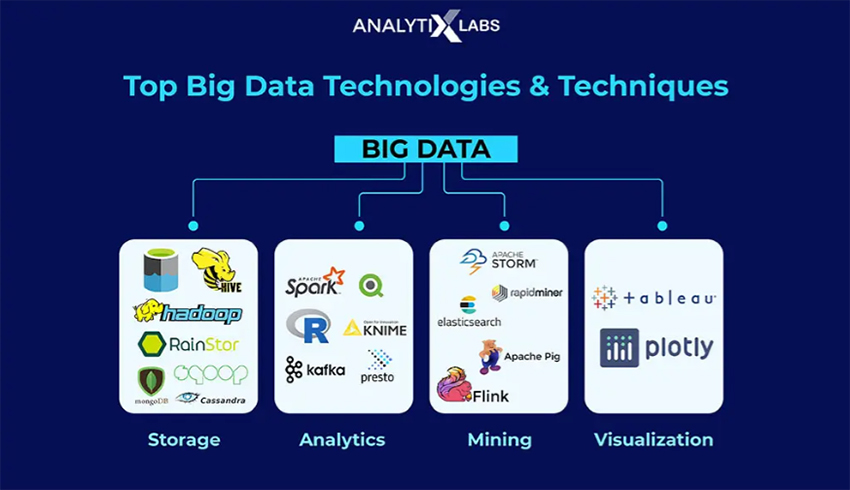Data has become one of the vital resources in today’s corporate world as it affects operations, competitive positioning, and strategy.
Big data analytics software allows an enterprise to collect, manipulate, and analyze a huge amount of both structured and unstructured data into insightful knowledge.
By analyzing patterns, predicting trends, or enabling data-supported decisions, these technologies create an environment for the genesis of innovation, enhancement of operational excellence, and long-term viability of a company in a broad spectrum of industries.
The smart use of big data analytics enables a company to define customer experiences, maximize performance, and identify new market opportunities with both speed and accuracy.
What is Big Data Analytics Software
Big data analytics software denotes sophisticated sets of tools and systems geared toward processing and analyzing huge amounts of structured and unstructured data.
Unlike conventional methods of data processing, these solutions are instead fitted to working on complex datasets retrieved from social media, sensors, transactions, and IoT devices.

Incorporating cloud computing, machine learning, and artificial intelligence, companies discover invisible trends, patterns, and correlations and make decisions accordingly.
Then, businesses improve customer experience, streamline systems, and glean actionable insights on new growth opportunities through these capabilities, all of which had been beyond traditional analytical means.
Key Drivers of Business Growth Through Big Data Analytics
1. Enhanced Decision Making
With big data analytics tools, enterprises can finally harness big data to improve the accuracy of decisions.
When organizations think about the past and about the present, they have a vast array of information about customer behavior, market developments, and operational performance.
To help organizations formulate decisions based on concrete facts instead of guesses or intuitions, historical and real-time data can provide relevant information to provide for inform and proactive strategies aligned to market needs, and therefore, should help improve overall business results.
2. Customer Insights and Personalization
Big data analytics enable organizations to monitor customer behaviors, interests, and demographics across multiple touch points in their interactions, including web interactions, past purchase history, and social media interactions, and develop an understanding of their customers.
With detailed insight, organizations can better segment their customers, personalize their marketing campaigns, and develop product offerings.
Creating experiences with specific customers can significantly enhance customer satisfaction, loyalty, and repeat business.
3. Operational Efficiency
Big data analytics assist companies in optimizing their operational activities by identifying inefficiencies and mapping out possibilities for improvement.
Through the analysis of operational data from various sources, organizations can better allocate resources and make processes more efficient.
Prediction analysis can also anticipate equipment failure, enabling businesses to intervene before breakdowns occur, thus cutting maintenance costs and time while raising productivity and efficiency.
4. Innovation and Product Development
It uses analytics from consumer feedback, industry trends, and competition activity to help organizations find market opportunities and gaps.
The new perspectives will empower them to innovate in a way that they can create and offer the products and services that adapt to the consumer needs to be the first to reignite the market.
With the use of data-driven insight, companies can maintain their leading position over competitors, adjust to the changes, and incessantly offer the products and services that are of importance and bring value.
5. Risk Management
Big data analytics has a significant impact on risk identification and prevention.
By exploring trends and anomalies in the data, companies can uncover the risks of fraud, cyber-attacks, or volatility in the market.
Taking a preventive approach, companies not only safeguard their assets and eminence but also react quickly to the latest threats.
6. Market Segmentation and Targeting
Businesses are able to precisely segment their consumer base because of the abundance of data available.
Here, one can categorize consumers into different segments, reselling their specific attributes, respecting demographics, and preferences.
This further demands a molding approach to marketing that speaks to a certain demographic group, thereby elevating conversion rates and ROI.
Implementing Big Data Analytics Software
In order for businesses to extract the value of big data analytics, the proper set of software systems should be adequately leveraged.
These software systems should all be selected based on scalability, integration capabilities, and the ability to incorporate advanced analytics.
Many organizations spend time distressing over how to successfully implement big data analytics, and will find a more successful outcome if they provide a methodical approach combining people, governance, and ongoing tracking.
Robust data governance provides the structure of security, quality, and compliance with government regulations.
Organizations also need to invest in developing a talented pool of engineers, analysts, and data scientists who can understand the findings and produce the relevant recommendations.
Organizations can simply emphasize the style of decision-making from these newly minted data-driven methodologies simply by tracking the project resources availability, expected timelines, performance tracking, and adjusting if appropriate, and most importantly, ensuring to align the time-sensitive analytical projects in response to ever-changing business priorities.
Industry Applications of Big Data Analytics Software
– Healthcare
Big data analytics software helps with patient data analysis in the healthcare industry, allowing for more individualized treatment regimens and better patient outcomes.
It also helps with resource allocation and disease outbreak prediction models.
– Retail
Analytics are used by retailers to estimate demand, improve inventory control and improve the purchasing experience for customers by offering tailored deals and recommendations.
– Manufacturing
Big data analytics is used by manufacturers to track production procedures, predict equipment maintenance requirements, and optimize supply chain activities, which saves costs and boosts output.
– Finance
In order to improve compliance and provide more specialized financial products, financial institutions use analytics for risk assessment, fraud detection, and client segmentation.
Challenges and Considerations
While there are numerous advantages to the utilization of big data analytics software, businesses must also evaluate a series of challenges.
Data quality and integration are among the initial challenges; it can be difficult to ensure the data collected from multiple sources is complete, accurate, and consistent, and inadequate data can skew analytical outcomes.
Analytical platforms can also be integrated into existing IT flow and workflows, which usually requires an investment in personnel and systems to account for these issues.
The lack of expertise in data analytics, interpretation, and the production of actionable insights is another significant challenge.
Organizations will need to consider data safety and privacy.
Organizations will need to ensure strong protections are put in place for data safety and compliance with regulations that are more robust.
Beyond technology considerations, change management will be necessary as a data-driven culture will require organizational leadership, staff engagement, and a willingness to change existing practices.
There are also costs of implementation, including software, hardware, training, and ongoing upkeep, which can be considerable.
Despite these difficulties, organizations that develop robust data governance, sustainable upskilling, robust security, and a planned change management strategy can unlock the complete value potential for big data analytics.
This will actually convert challenging data into meaningful insights towards sound decision-making and sustainable growth inside the organization.
Future Trends in Big Data Analytics Software
Artificial Intelligence and Machine Learning
The expansion of big data analytics, artificial intelligence, and machine learning has helped organizations to discover valuable insights to help them predict future trends.
With this ability, organizations are capable of making knowledgeable decisions.
Besides, organizations can automate complex decision-making and remove human analysis.
This speeds up their response to the fast-paced business environment. Moreover, the ability of AI and ML systems to learn continually from fresh data is a critical feature.
It entails giving them the chance to make their predictions and suggestions more accurate.
In situations where AI and ML systems are customer assistants, the customer experience is made better, the business is optimized for efficiency, and the business can generate more profound insights from the increased and complex datasets.
Edge Computing
Through minimizing latency and decreasing bandwidth consumption, edge computing at the edge of the network provides real-time analytics in a wholly new way.
Organizations can make faster decisions and realize instant insights by analyzing data locally rather than sending data to centralized servers.
This is particularly important for applications that require instantaneous responses.
Healthcare can be one sector that can benefit from fast data analysis in monitoring patients and deploying timely medical interventions, while manufacturing industries can take advantage of real-time equipment monitoring and predictive maintenance.
In addition to improving operational efficiencies, this approach reduces dependencies on cloud infrastructures and lowers network congestion, resulting in better analytics practices and solutions that are more resilient and scalable in less stable and data-rich situations.
Cloud-Based Analytics
In cloud-based grand-scale analytics, big data analytics software plays a major role in ensuring that businesses handle, process, and derive value from large and very diverse information.
Cloud platforms’ scalable storage and processing systems provide big data analytics capabilities and do not come with the design restrictions of on-premises infrastructures.
By leveraging cloud-enabled analytics, organizations can take advantage of new technologies, such as machine learning and artificial-intelligence-based algorithms, come together with data from multiple sources around the world, analyze large amounts of live data, and do so from anywhere.
The power of accessibility, flexibility, and cost-effectiveness provides organizations with the ability to adjust resources depending on demand and get insights even if they are scattered across multiple regions.
Big Data Analytics Software Market
The big data analytics software market is expanding rapidly as more companies are harnessing data for informed decisions, process tools, and innovation.
Across industries, including manufacturing, retail, healthcare, and finance, we are seeing early trends of large adoption and demand for powerful analytics systems and the associated ability to manage structured and unstructured data at scale.
Organizations want scalable, secure, and user-friendly software to enhance customer experience, gain a competitive advantage, and glean meaningful insights from large, unstructured, and complex data.
With the advancement of technology, we now live in a data-driven corporate culture. The advantage of utilizing big data analytics software has gone from a competitive advantage to a necessity.
Pristine Market Insights states that big data analytics software helps companies develop good decision-making, improve operational processes, provide personalized buyer experiences, and manage risk through the ability to turn large volumes of raw data into useful insights.
Aside from the direct operational advantages, big data analytics additionally aids the company to broaden its strategy and encourage innovation through the facility to anticipate market trends, uncover marketing opportunities, and maintain a competitive advantage.
There are issues with big data implementation, namely data quality, data integration, and data security, but companies that have a well-managed and deliberately organized approach are in a good position to unlock the maximum value of these technologies.
As technology continues to evolve, big data analytics will increasingly help businesses manage complexity within markets and evolve as a critical enabler of sustainable business.









